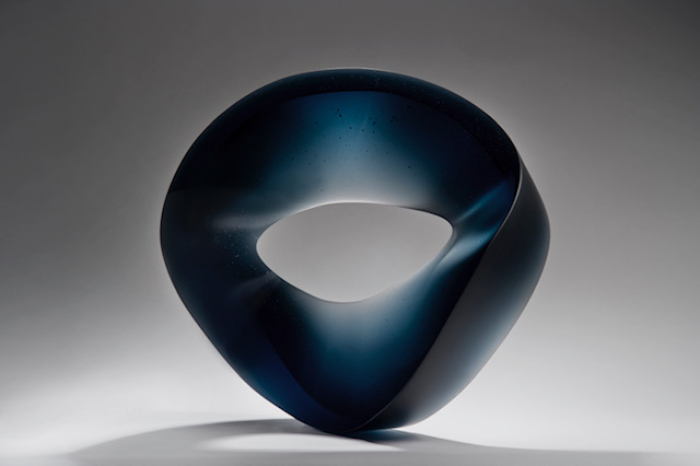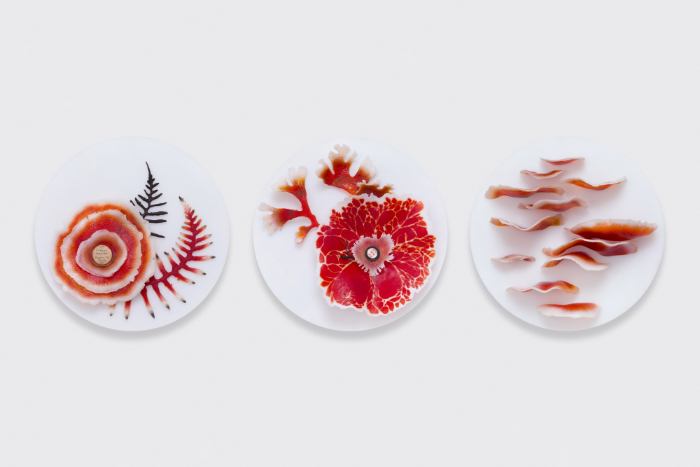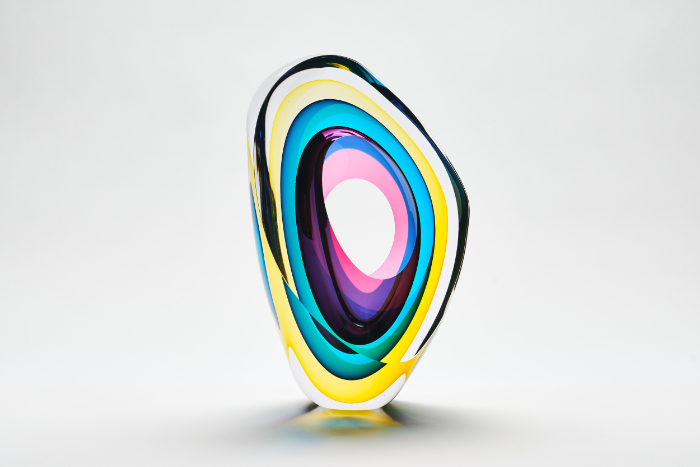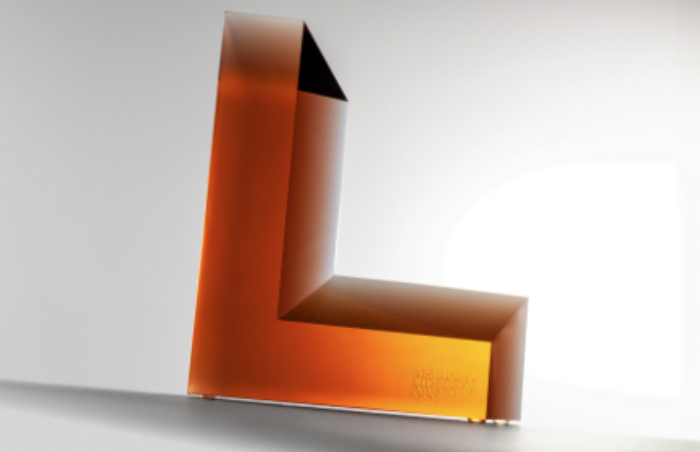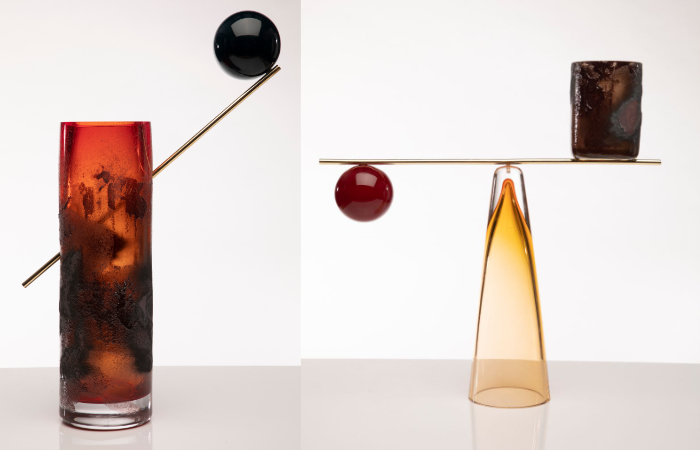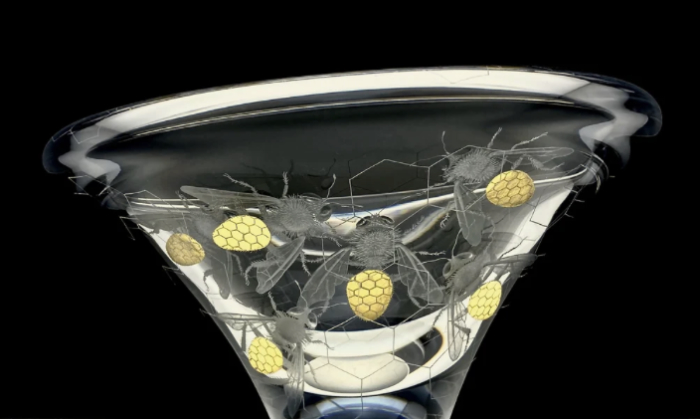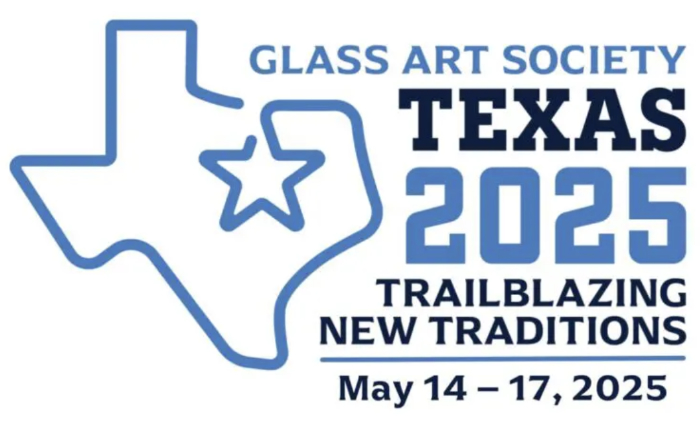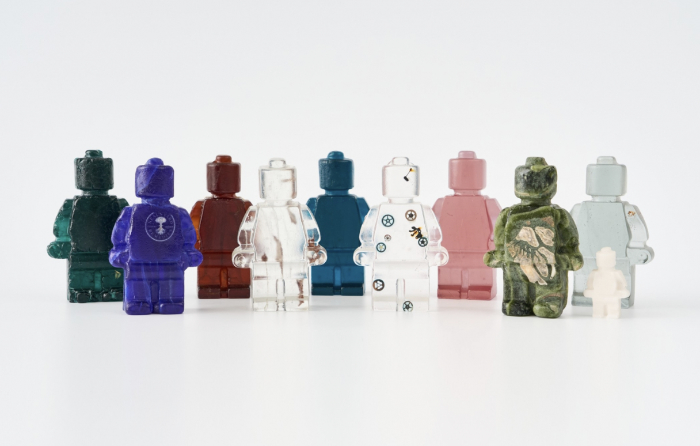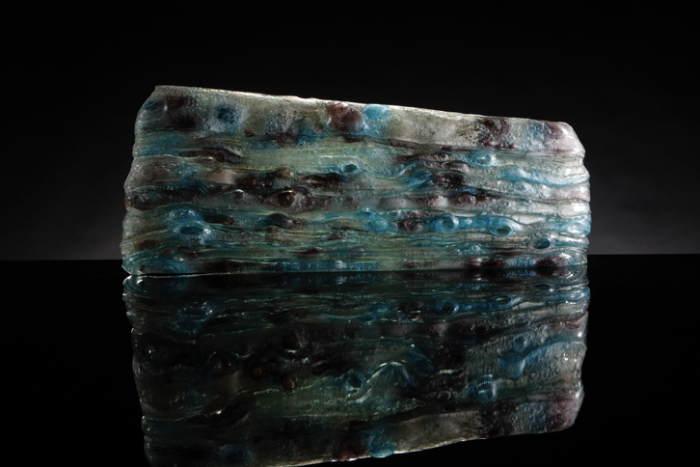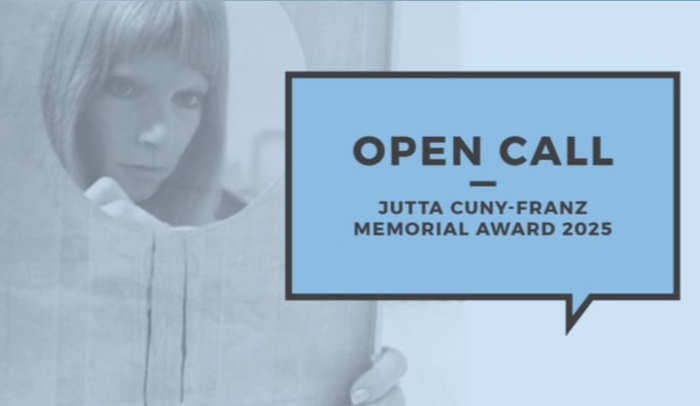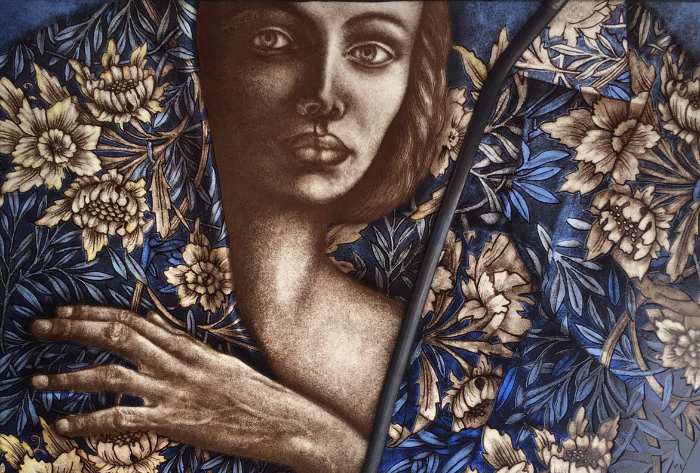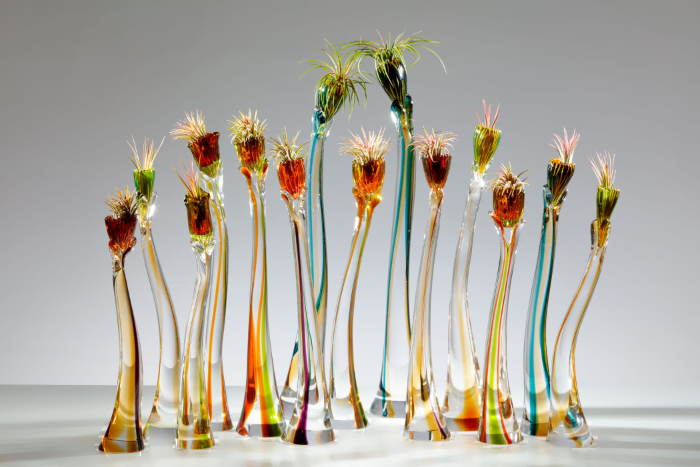
Allister Malcolm is known for his glass art and, more recently, his appearances as a mentor on the tv series Make It At Market. As his studio moves towards increasingly sustainable practices, he has been inspired to create new work reflecting this journey. Linda Banks finds out more.
You are recognised internationally for your accomplished glass work. What led you to start working with glass originally?
Whilst on a Foundation course in art and design, my eyes were opened to the variety of degrees available in the creative environment. Initially I had been considering a degree in fine art, painting, illustration or sculpture. At that time I had a Saturday job with two metal sculptors working in the public art sector – Hilary Cartmel and Michael Johnson. They had both trained in the fine arts and had developed their skills enough to self-fabricate ambitious projects. Witnessing how they paved their way as artists gave me a valuable insight into what life might be like as an artist in a commercial world. It also convinced me that I should look at gaining a skill. I’d watched glassblowing and, like many others, was fascinated by glass in its molten state. With that in mind, I looked around various universities before taking the leap and applying to Wolverhampton.
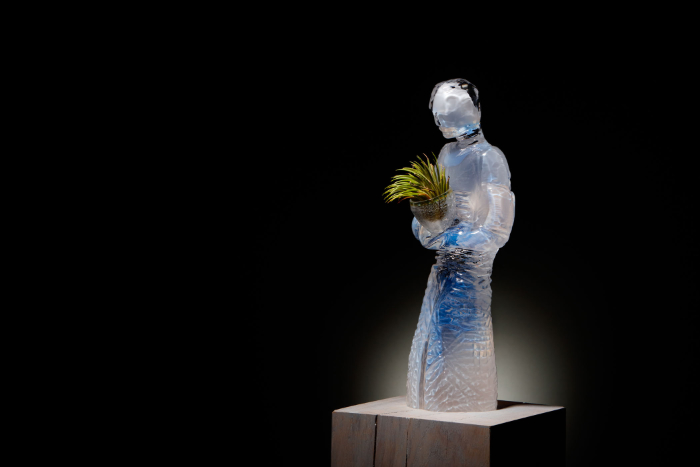
What glass techniques have you used and which do you prefer?
I’ve been lucky enough to have tried many techniques, including blowing glass freehand and mould blowing (I separate the two as they require different skills), sand casting, cane work, hot sculpting, hot glass surface embellishment, overlay work, cutting (lathe work) and sandblasting. I’ve tried many more, but I have invested time in these processes. I am drawn to work with glass in its molten state as it allows me to be as hands-on with the material as possible.
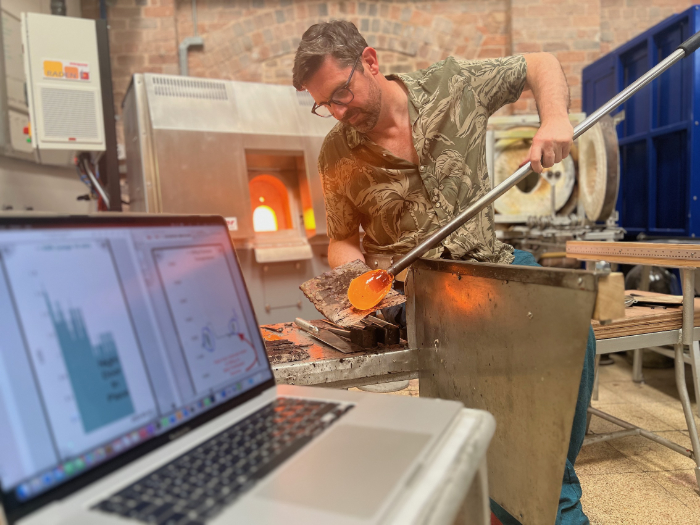
What is your creative approach to new projects? Do you draw out the designs or dive in with the materials?
I tend to mull things over in my mind for a few days before putting anything down on paper. This my favourite part of the process – the development of a new concept. It seems that everything we do in the studio now requires a creative response. I enjoy it as it keeps me interested.
I have to admit that initial drawings do not necessarily get put neatly in to a sketchbook. The fast pace of running a glass studio means the initial scribbles are often on the nearest piece of paper. We often say, “The best-laid plans are made on the back of an envelope!” As these initial ideas are developed they become a little neater, at which point they may be presented to a client. Once I’ve got a good idea of what we are aiming for, I step into the hot shop to carry out the first trial. The cost of time in the hot shop, both financially and environmentally, means that we don’t enter without a clear goal.
Even with decades of experience, the process can still be unpredictable. It’s rare that a new concept can be produced perfectly or as I envisioned it on the first attempt. Sometimes, the initial tests sit on a shelf teasing me for a few days before I get the chance to develop them. The commercial pressures of running a studio mean that I juggle multiple projects and I have to prioritise.
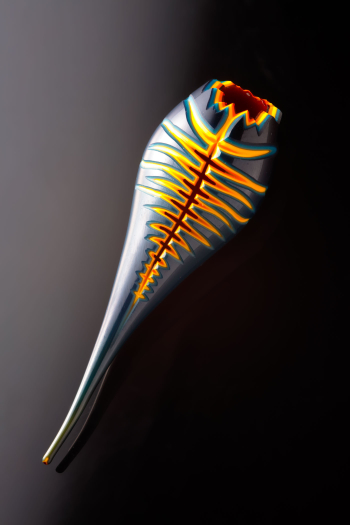
You have taken several steps to make your studio at the Stourbridge Glass Museum more environment friendly. Please tell us about what you have achieved so far and what further actions you have planned.
I regularly walk in to the studio and stop to take it all in. It’s hard to believe how much has changed in the last year; its been a whirlwind. The online presentation I gave to the Contemporary Glass Society (CGS) in 2023 highlighted the advantages to converting a hot shop to electric. Here is a timeline showing the physical steps we’ve taken:
- April 2023: glass studio rewired in preparation for new equipment to be installed. Switched to recycled/compostable packaging
- May 2023: electric furnace installed, commissioned by Interpower Induction Ltd. First pieces produced
- June 2023: planning consent obtained for a larger solar panel installation for the museum and the studio. I coordinated quotes and sought proposals for the photovoltaic systems
- July 2023: electric annealing oven installed by KilnCare
- September 2023: electric reheating chamber installed
- October 2023: Presented in-depth talk to CGS about the benefits of converting a gas studio to electric, the highlights of which were published on my YouTube channel
- November 2023: we run on 95% electric power for the first time
- December 2023: structural survey complete, with weight loadings approved for solar panel installation at the museum
- January 2024: tests on the electric reheating chamber concluded. Feedback provided to manufacturer. Upgraded version discussed and approved. Consequently I confirmed an order for the upgraded version
- Feb 2024: upgraded wiring and our own (and the UK’s first) electric gloryhole/reheating chamber installed – the first of its kind in Europe
- March 2024: Electric gloryhole installed
- April 2024: Stourbridge Glass Museum awarded ACE capital investment funding for installation of solar panels to power the museum and the hot glass studio. I provided much of the research and was the driving force behind some of the detail.
- April 2024: Terri Malcolm (my wife) develops a way to use glass offcuts for workshops and uses all our waste glass for awards
- May 2024: electric contract switched to EDF 100% renewable energy
- May 2024: solar panel installation scheduled for Autumn 2024.
Discussions are ongoing with a manufacturer on the last piece of equipment required (an electric pipe warmer). The aim is to complete its installation by the Autumn and to be the first running on 100% renewable energy (a percentage of which we generate ourselves).
We know from the changes that we have made that we have vastly reduced our carbon footprint. Our calculations prove we are saving a great deal of carbon emissions – equivalent to the carbon emissions generated by a family car driven 3.5 times around the planet annually – even before the solar panels are installed.
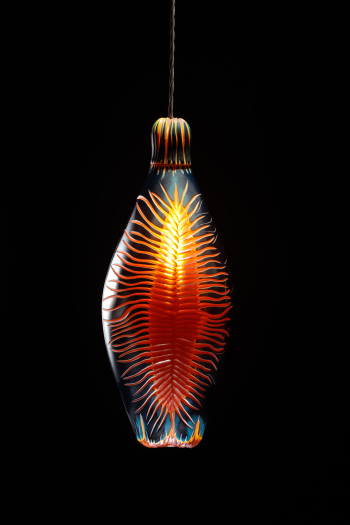
Has moving from gas to electric impacted your working practices?
Consider this: you have been cooking on a gas stove for decades. With little warning you are asked to switch to the world’s first air fryer. You have been told this new equipment is capable of doing the same job, but where do you start? What are your timings? You are way out of your comfort zone, but who can guide you? This is the predicament that I have found myself in for the last year, with no one to ask for advice. I realise that I’m helping to write the guidelines for others to potentially follow. Yes, this is scary. We have had to adapt timings and get used to a different way of working. It’s also very exciting and I am proud to have been in the position to be the first to embrace this way of working and showcase its potential.
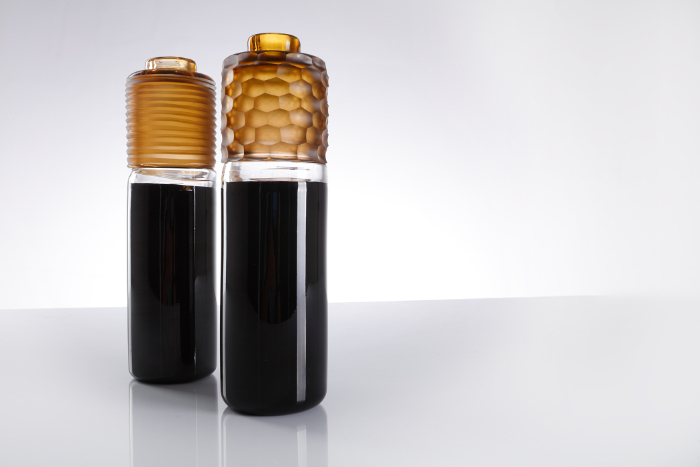
What message(s) do you want to convey through your art?
A pivotal moment for me was experiencing the worst effects of the energy crisis. My studio was hit so hard I thought that I would cease to continue as a professional glass artist. By transitioning to 95% renewable energy sources in my art and consciously stepping away from fossil fuels, it has felt like a fresh start.
Recently, I developed an interest in air plants. I use them to depict a biodiverse and healthy scene in some of my latest work. These plants rest within coloured vessels and stems to create a vibrant landscape, encouraging the viewer to feel positive about adopting sustainable practices.
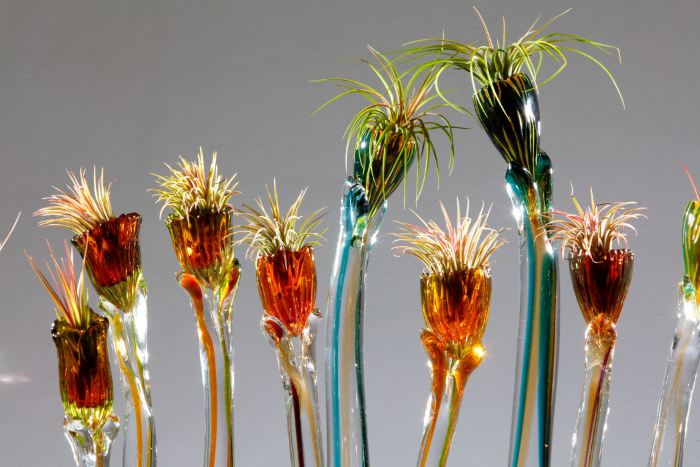
Do you have a favourite piece you have made? Why is it your favourite?
I find my latest pieces, displayed as a collection with the plants, really uplifting. Glass has been used for such a long time to display flowers and foliage and I am enjoying putting a new spin on this. Taking tiny plants and elevating their status has been a new direction, both visually and conceptually. It has also been a long time since I have produced anything figurative and I am enjoying the challenge that this brings.
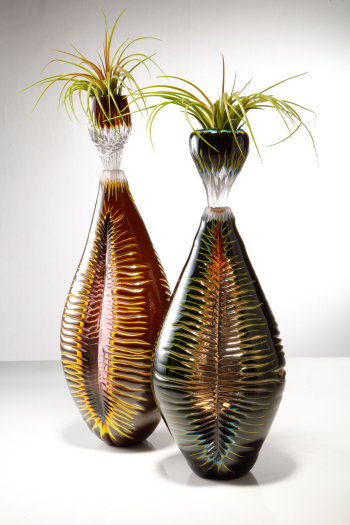
You have been a mentor to emerging glass artists on the tv series Make It At Market. Please tell us more about that experience and any challenges and opportunities.
This was such a rewarding experience. One of the biggest challenges was to present each artist with a different set of goals. I had to be careful and consider that it would not make good tv viewing to see me week after week repeating the same message. As soon as I met the artists and heard their stories I saw that each had particular strengths that would lead in different directions. I knew how I could help to make a positive impact on their careers. The filming seemed incidental, as I enjoyed the process so much.
Cameras followed us over the course of a few months while I was still running the studio and providing glassmaking activity for the public visiting the museum. There were some long days as a result. It felt odd when the filming ceased and we had to wait for the show to be aired – it seemed a desperately long wait.
I am really proud of how each artist performed during the process and enjoy seeing success come their way. I am aware a callout has been circulated by Flabbergast TV for series three of Make It At Market and I would encourage anyone to apply!
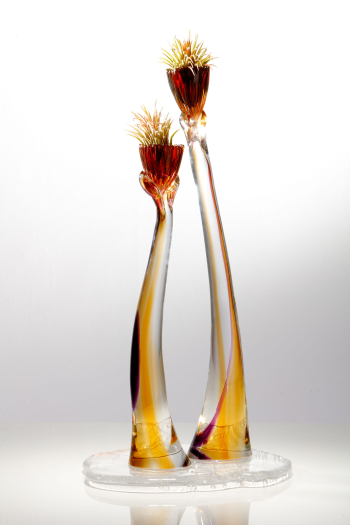
Where is your glass practice heading next?
If you had asked me this question 18 months ago, I would not have given a positive response. The energy crisis had hit me hard and I honestly thought it was in my last year as a professional glass artist. The exciting thing about life is that my exact direction is not known. I know what we have lined up for the next four or five months. We are working on a couple of exciting projects that we can’t discuss right now.
I feel like I have been given a second chance, as converting to electric has set us up for the future and, with this, new work is emerging. I am looking forward to seeing the response. I am also embracing the notion that we have the perfect studio and position to help inspire the next generation of glass enthusiasts. To summarise, I feel very positive about the future.
Find out more about Allister Malcolm and his glass practice via the website.
Main feature image: Allister Malcolm’s ‘The Thriving Canopy’ elevates air plants and encourages the viewer to feel positive about adopting sustainable practices. Photo: Simon Bruntnell.
